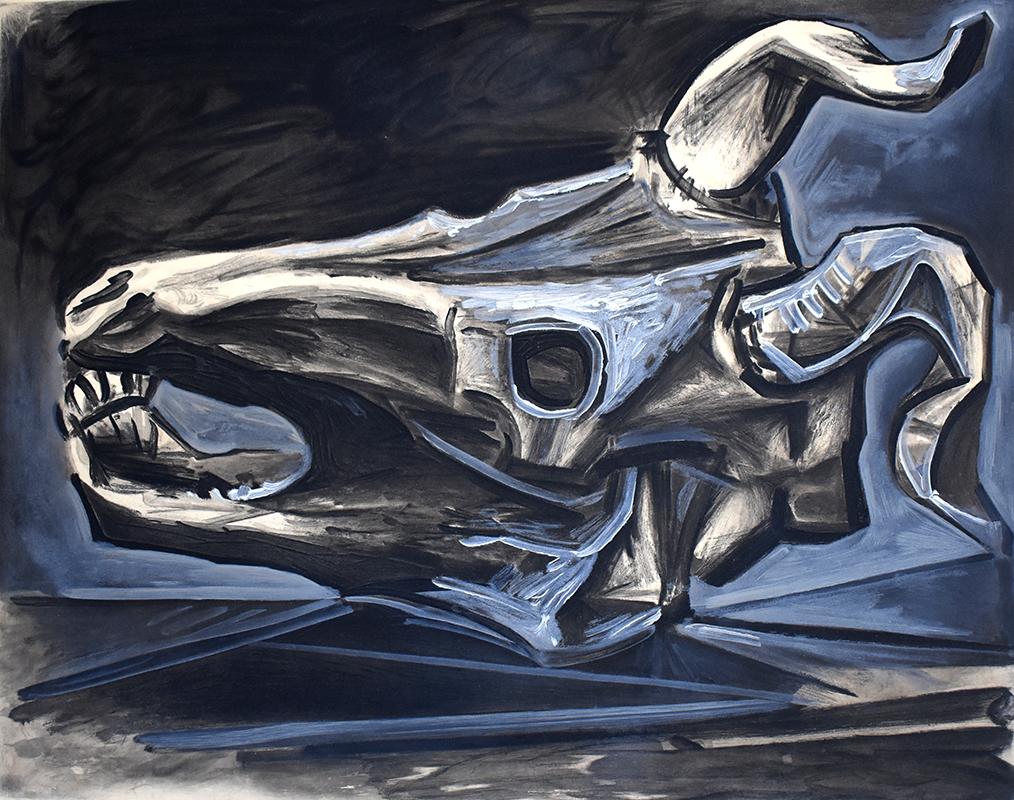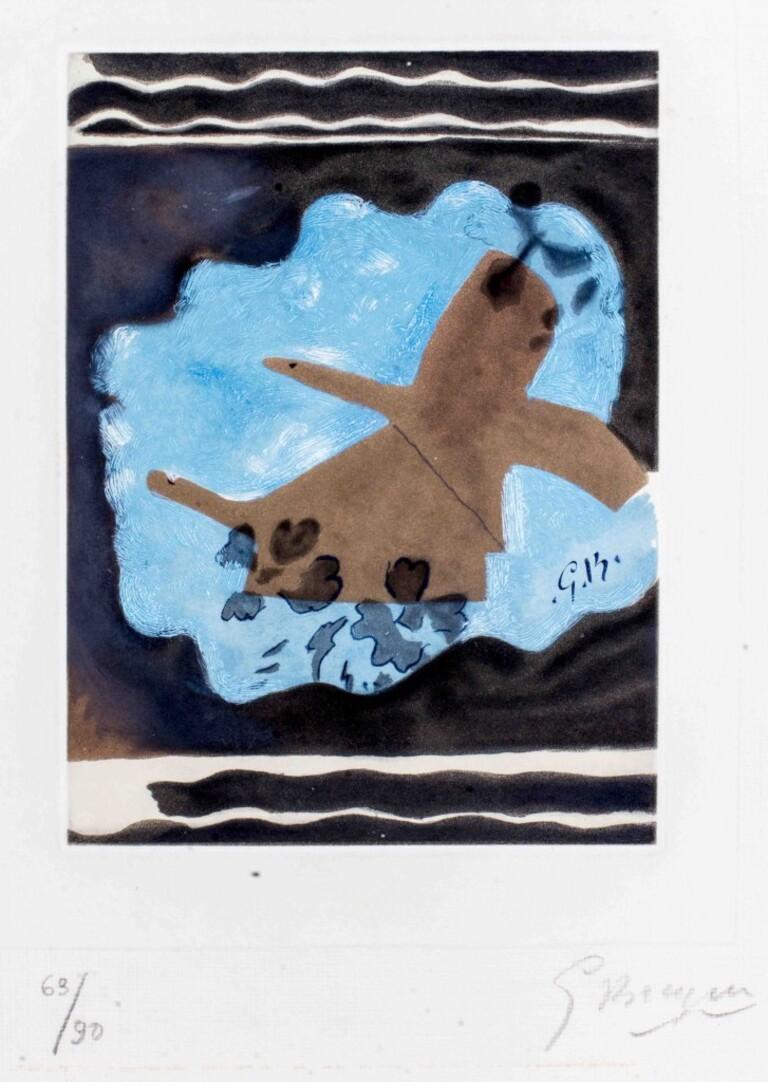Items Similar to Baj Chez Picasso 2, Aquatint Etching by Enrico Baj
Want more images or videos?
Request additional images or videos from the seller
1 of 5
Enrico BajBaj Chez Picasso 2, Aquatint Etching by Enrico Baj1969
1969
About the Item
Artist: Enrico Baj, Italian (1924 - 2003)
Title: Baj Chez Picasso 2
Year: 1969
Medium: Aquatint Etching, Signed and numbered in pencil
Edition: 86/100
Image Size: 15 x 22 inches
Size: 19.5 in. x 28 in. (49.53 cm x 71.12 cm)
- Creator:Enrico Baj (1924-2003, Italian)
- Creation Year:1969
- Dimensions:Height: 19.5 in (49.53 cm)Width: 28 in (71.12 cm)
- Medium:
- Movement & Style:
- Period:
- Framing:Framing Options Available
- Condition:
- Gallery Location:Long Island City, NY
- Reference Number:1stDibs: LU466159052
About the Seller
4.8
Platinum Seller
These expertly vetted sellers are 1stDibs' most experienced sellers and are rated highest by our customers.
Established in 1979
1stDibs seller since 2014
2,693 sales on 1stDibs
Typical response time: <1 hour
- ShippingRetrieving quote...Ships From: Long Island City, NY
- Return PolicyA return for this item may be initiated within 7 days of delivery.
More From This SellerView All
- Acrobat, Aquatint Etching by Max PapartBy Max PapartLocated in Long Island City, NYAcrobat Max Papart, French (1911–1994) Date: circa 1982 Aquatint Etching with Carborundum, Collage, signed and numbered in pencil Edition of 6/53 Image Size: 24 x 38 inches Size: 30 ...Category
1980s Cubist Animal Prints
MaterialsAquatint, Etching
- The Red Horse, Aquatint Etching by Max PapartBy Max PapartLocated in Long Island City, NYThe Red Horse Max Papart, French (1911–1994) Date: 1981 Aquatint Etching with Carborundum, Collage, signed and numbered in pencil Edition of 8/50 Image Size:...Category
1980s Cubist Animal Prints
MaterialsEtching, Aquatint
- "Amour from the Helene Portfolio" Lithograph by Andre MinauxBy Andre MinauxLocated in Long Island City, NYArtist: Andre Minaux, French (1923 - 1986) Title: Amour from the Helene Portfolio Year: 1974 Medium: Lithograph, signed and numbered in pencil Edition: 150, XXX Size: 25.75 in. x 19....Category
1970s Cubist Animal Prints
MaterialsLithograph
- Oiseau Multicolore, Cubist Etching by Georges Braque 1950By Georges BraqueLocated in Long Island City, NYOiseau Multicolore by Georges Braque, French (1882–1963) Date: 1950 Aquatint Etching, signed and numbered in pencil Edition of 69/200 Image Size: 10 x 19.5 inches Size: 17.75 x 25.25...Category
1950s Modern Animal Prints
MaterialsAquatint, Etching
- Blue Jays, Aquatint Etching by Martin BarooshianBy Martin BarooshianLocated in Long Island City, NYBlue Jays Martin Barooshian, American (1929–2022) Date: circa 1981 Intaglio Etching and Aquatint, signed and numbered in pencil Edition of 175, AP 25 Image S...Category
1980s Animal Prints
MaterialsEtching, Intaglio, Aquatint
- Music Box Bird, Aquatint Etching by Tighe O'DonoghueLocated in Long Island City, NYMusic Box Bird Tighe O’Donoghue, American (1942) Date: circa 1980 Etching with Aquatint, signed and numbered in pencil Edition of 200 Image Size: 20 x 15.5 inches Size: 25.5 in. x 20...Category
1980s Animal Prints
MaterialsAquatint, Etching
You May Also Like
- Goat Skull on the TableBy (after) Pablo PicassoLocated in London, GBPABLO PICASSO 1881-1973 Málaga 1881-1973 Mougins (Spanish) Title: Goat Skull on the Table Crâne de chèvre sur la table, 1953 Technique: Hand Signed and ...Category
1950s Cubist Animal Prints
MaterialsAquatint
- PEINTRE AU TRAVAIL (BLOCH 1157)By Pablo PicassoLocated in Aventura, FLEtching, aquatint, drypoint and scraper, on Rives BFK paper. Hand signed and numbered by Pablo Picasso. Published by Galerie Louise Leiris, Paris. Image size 12.125 x 18.125 inches. ...Category
1930s Cubist Animal Prints
MaterialsDrypoint, Paper, Aquatint, Engraving
- Le Singe - Etching by Pablo Picasso - 1940sBy Pablo PicassoLocated in Roma, ITNot Signed. Not Numbered. Edition of 225 pieces. Etching - aquatint. Belongs to the Suite "Histoire Naturelle de Buffon". Catalogue Bloch n.339. Passepartout included.Category
1940s Cubist Figurative Prints
MaterialsEtching, Paper
- Migration - Etching by Georges Braque - 1962By Georges BraqueLocated in Roma, IT" Migration " is an etching realized by Georges Braque in 1962. The print is hand signed and numbered. This is an edition of 90 prints. Bibliography: D. Vallier, Braque : l'oeuvr...Category
1960s Cubist Animal Prints
MaterialsEtching
- Jean Cocteau - Europe's Agriculture - Original LithographBy Jean CocteauLocated in Collonge Bellerive, Geneve, CHOriginal Lithograph by Jean Cocteau Title: Europe's Agriculture Signed in the stone/printed signature Dimensions: 33 x 46 cm Luxury impression from the portfolio published by Sciaky....Category
1960s Cubist Animal Prints
MaterialsLithograph
- After Georges Braque - Antiborée - LithographLocated in Collonge Bellerive, Geneve, CHLithograph after Georges Braque. Signed in the plate Edition of 150 Dimensions: 76 x 117 cm Bibliography: « Les Métamorphoses de Braque» of Heger de Loewenfeld and Raphaël de Cuttoli , Editions FAC, Paris, 1989. In 1961 Georges Braque decided with his laidary friend Heger de Loewenfeld to pick up certain of his works to in order to create artworks, this beautiful litograph is one of them. Héméra in the Mythology: In Greek mythology Hemera was the personification of day and one of the Greek primordial deities. She is the goddess of the daytime and, according to Hesiod, the daughter of Erebus and Nyx (the goddess of night). Hemera is remarked upon in Cicero's De Natura Deorum, where it is logically determined that Dies (Hemera) must be a god, if Uranus is a god. The poet Bacchylides states that Nyx and Chronos are the parents, but Hyginus in his preface to the Fabulae mentions Chaos as the mother/father and Nyx as her sister. She was the female counterpart of her brother and consort, Aether (Light), but neither of them figured actively in myth or cult. Hyginus lists their children as Uranus, Gaia, and Thalassa (the primordial sea goddess), while Hesiod only lists Thalassa as their child. The father of Cubism Three Cubist that distinguishes art historian periods were initiated and developed by Georges Braque: The Cubist Cézanne (1907-1909), Executive (1909-1912) and synthetic (1912-1922). Post-Impressionist and fawn, Braque no longer adheres to the contingency of a decorative way or the other. Cézanne’s paintings exhibited at the Grand Palais during the retrospective of 1907 are a revelation: Cézanne sought and invented a pictorial language. In his footsteps, Braque went to the South with the reasons of the Master. He returned with Estaque landscapes and surprising Ciotat it keeps Cezanne geometric model and retains the “passages” continuity from one surface to another to create the sensation of “turning around” of the object represented. But he wants to go after the consequences of the vision of Cezanne. In his paintings Houses in L’Estaque (1908) it simplifies the volumes of houses, neglects detail by removing doors and windows: the plastic rhythm that builds the table. Large Nude , a masterpiece of the period, can be considered the first work of Cézanne cubism . Systematizing and deepening Braque discoveries open the door analytical cubism. In 1909, his painting became more cerebral than sensual. The pattern is recreated in the two-dimensionality of the canvas, leaving aside any illusionistic perspective. In Still Life with Violin, objects are analyzed facets according to their characteristic elements, each facet referring to a particular view of the object. There are so many facets of points selected view: Table reflects the knowledge of the object and the ubiquity of the eye. Moreover, Braque is looking for the essence of the objects in the world rather than their contingency, which explains the absence of light source and use of muted colors (gray, ocher), contingent aspects of the object . But formal logic has stepped facets, erased any anecdote to the object and ultimately led to his painting a hermetic more marked on the edge of abstraction (see the series of Castle Roche-Guyon ). Braque, anxious to keep the concrete and refusing at all costs that the logic of Cubism takes the paintings to abstract, reintroduced signs of reality in his paintings in 1912 marks the beginning of Synthetic Cubism. Historians speak of “signs of real” rather than reality because what interests Braque, this is not to put reality into a table, but to create a painting which, by its language, refers to the real. To do this, he invented two major techniques XX th century inclusions and contributions. The inclusions consist of painting objects that have no real depth, materials (wallpaper in Nature morte aux playing cards faux wood is a pictorial inclusion) or letters (calligraphic inclusion in Portuguese ), made first brush and a few months later stencil. Contributions are defined in contrast with the collage on canvas of foreign materials: glued or sand paper, sawdust, etc.. Regarding the collages, Braque used for the first time in September 1912 a piece of adhesive paper imitating faux wood Compote...Category
1950s Cubist Animal Prints
MaterialsLithograph
Recently Viewed
View AllMore Ways To Browse
Picasso Pencil
Picasso Pencil Print
Picasso Pencil Signed
Picasso Etching Print
Signed Picasso Etching
Picasso 28
Picasso Aquatint
Picasso Signed Aquatint
Baj Enrico
John James Audubon Original
Blue Dog Print Signed
Morris Bird Prints
Illustration Male
Large Audubon Print
Elephant Watercolor
T Lewis
J Clark
Audubon Bird Prints Antique


